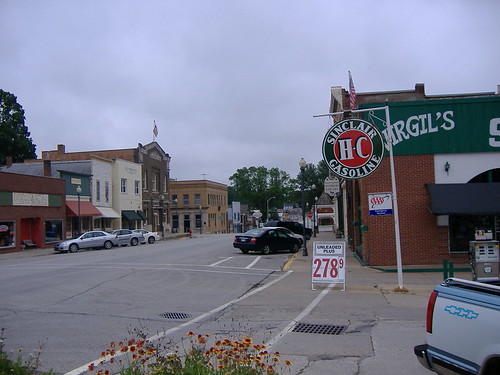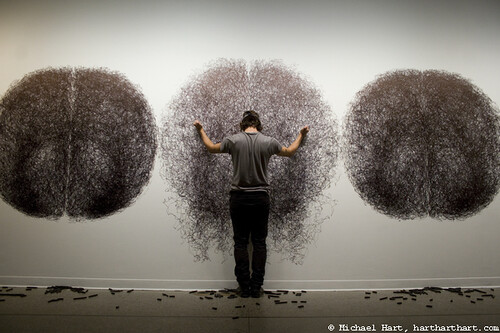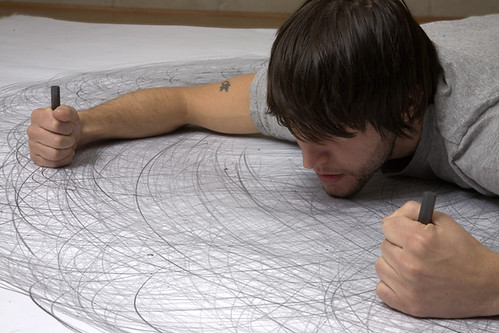TONY ORRICO: “NO ESTOY INTENTANDO FUSIONAR ARTES VISUALES Y DANZA”
ACTUACIONES EN LP: Domingo 6 (Penwald: 2: 8 circles) y jueves 10 (Penwald: 3: circle on knees)
LUGAR: CCCB
HORA: 20 horas
Comienza el Lp, comenzamos Sin Hueso (espacio para la expansión reflexiva). El festival empezará con Bea Fernández, Sonia Gómez y Sergi Faüstino el viernes y el sábado en el CCCB. El domingo llega desde Nueva York Tony Orrico. Para mí, desconocido hasta ahora. Por eso, he decidido hacerle una entrevista por mail, para conocer. Estuve en su página, investigué por la red lo que pude y le he hecho una serie de preguntas que creo nos acercan a este artista que llegará con dos trabajos de su serie “Penwald”.
(scrolldown for English)
TONY ORRICO: “NO ESTOY INTENTANDO FUSIONAR ARTES VISUALES Y DANZA”
Primero, te propongo una especie de juego. Me encontré esta bio clásica en esta página (http://www. dancetheaterworkshop.org), está bien hecha, no hay problema con lo que dice. Pero las bios, creo, siempre pierden hechos importantes, cosas que podrían explicar mucho mejor desde dónde y porqué haces tu trabajo. Por lo tanto, te propongo que le añadas tres o cuatro cosas (lo que quieras) a esta bio:
(Hinsdale, Illinois, 1979). Artista visual y performer. Actualmente trabaja en una serie de dibujos de contorno bilaterales titulada Penwald Drawings. Su trabajo ha sido recopilado por la National Academy of Sciences de Washington DC y encargado por Flux/S en Strijp-S de Eindhoven (Holanda) y el Dance Theater Workshop de Nueva York. Actualmente está creando un diseño visual para la obra Canyon del coreógrafo John Jasperse, que se estrenará en la Brooklyn Academy of Music (septiembre de 2011). Una exposición en solitario de sus Penwald Drawings se verá en la Shoshana Wayne Gallery de Santa Mónica (California) en mayo de 2011. Ha sido miembro de la Trisha Brown Dance Company (2006-2009) y de Shen Wei Dance Arts (2003-2006). La pasada primavera participó como “re-performer” en la retrospectiva de Marina Abramović en el MoMA de Nueva York.
Tony Orrico: Cuatro cosas:
1. Mi abuelo es pintor. Tiene 94 años y vive con Alzheimer. Me enseño a pintar flores cuando era muy joven, y hace sólo unas semanas pintamos juntos (era la segunda vez que lo hacíamos). No dejó de preguntar qué estábamos pintando pero en ningún momento paró la actividad de su pincel. Yo no dejé de decirle que eran flores, él pintó montañas. Él es el primer modelo de artista que tuve. A partir de ese momento, mis padres me construyeron un estudio de pintura y me dediqué por entero a la pintura, tal como mi abuelo hizo.
2. Crecí en Chicago y he estado viviendo en Nueva York durante ocho años. Recientemente me he mudado a West Branch, IA. Tan sólo hay una manzana de casas en la calle, la mayoría de los vecinos son de pelo blanco y completamente generosos, y hay silenciosos campos de soja y maíz en todas las direcciones. Es tiempo de que focalice en mi creatividad y tengo una ilimitada cantidad de espacio y tiempo. Echo de menos Nueva York.

Imagen de West Branch, pequeña localidad en la frontera del Estado de Iowa con Ilinoiss (lo que los americanos denominan el “deep middle”.
3. Tengo mis propias técnicas somáticas que utilizo tanto en mis improvisaciones de movimiento como en mis dibujos; activan mi sentido de la simetría y la propiocepción. Me interesa trabajar con este nivel de conciencia durante el proceso y la creación de la performance. Creo que el refinamiento de un trabajo acabado proviene de la integridad del proceso de la pieza. Trabajo para mantener la claridad en la intención, la dirección y el fundamento. Esto también puede amplificar el intercambio de energía entre la experiencia visual y el público. Provoca que el aire se cargue de cierta sensibilidad compartida, de imaginación.
4. Aunque estoy formado en bastantes prácticas visuales, tengo el deseo secreto de poder cantar y tocar algún instrumento. Me imagino la gran y satisfactoria libertad y la cantidad de registros para expresar las experiencias e ideas que puedes encontrar a través de la voz y el ritmo.
Leyendo y mirando videos en la web pude ver que en tu trabajo existía una preocupación por cómo las artes visuales y la danza podrían dialogar. La serie de Penwald, del que mostraras dos trabajos en el LP, es un ejemplo de cómo encontrar un espacio común para que estas “disciplinas” interactúen… Utilizo palabras pobres para explicarme (disciplinas, interactuar, diálogo…). ¿Podrías intentar explicar cómo esto funciona en tu cabeza y tu trabajo?
T.O.: No estoy intentando fusionar estas formas de arte. No empecé a bailar hasta la universidad, y mi acercamiento a la danza siempre ha sido desde mis trabajos de pintura y dibujo. Mi habilidad de poder improvisar al mismo tiempo que producir líneas limpias, formas y cualidades me es intrínseca, pero atribuyo la mayoría de mi progreso a mi sentido del tiempo, el espacio y la composición, cosas que todavía están en desarrollo. La modalidad de cómo deseo investigar y actualizar mis ideas cada día me preocupa menos. Me aseguro la flexibilidad de navegar entre medios y graduaciones de formas existentes. Lo que encuentro aquí como común, ¿es cómo yo vería e interpretaría el espacio? ¿y podría juzgar esta interpretación válida para cualquier artista? Tenemos una única e ineludible existencia (con un montón de influencias, aversiones, atracciones, etc.) que determinan nuestra percepción creativa. Estoy intentando abrir posibilidades limitando, restringiendo, aquello que condiciona mi cuerpo, la superficie y el rastro de la experiencia.
Cuéntanos algo acerca de trabajos como “Importal” o “Raised Relief”, del 2008. Son trabajos que creo tienen que ver, al igual que los que vas a mostrar en Barcelona, con el paisaje y la relación con la pintura…
T.O.: Desarrollé una técnica durante ese periodo, documentaba solos a través de una técnica a la que denominé “reciting space”. Se puede entender como una transcripción de la arquitectura de mi alrededor al mismo tiempo que un viaje alrededor de paisajes internos. Estaba también trabajando con diferentes capas de conciencia, considerando los elementos de composición en su abandono, como si ondearan y se concatenasen instantáneamente. Empecé a hacer estos videos en mi último año de gira con la compañía de Trisha Brown. Son ligeramente egocéntricos. La mirada estaba puesta en mí. ¿Qué elecciones puedo tomar en este camino de supervivencia? ¿Qué pinta tengo cuando estoy creyendo en mí? ¿Dónde estaba escondida mi curiosidad? ¿Qué viene después de un cuerpo entrenado?
Leo en una crítica publicada en el Ballet-dance Magazine, esto sobre la serie de Penwald: “Esta actuación probablemente no aparece en el DC calendario de danza porque ha sido clasificada como “perfromance art” y no como danza, y fue organizada por el Programa Cultural de la Academia Nacional de Ciencias. Su programación explora la relación de las artes y las ciencias, ingenierías y medicina, y las actuaciones son abiertas, gratis, para el público”. ¿Cómo son entendidos y acogidos los trabajos híbridos en Nueva York? ¿Hay problemas para que sean exhibidos y comprendidos? ¿Hay espacios que entiendan esta clase de trabajos donde podáis exhibirlos?
T.O.: No he encontrado verdaderas críticas acerca de mi trabajo o de como estoy organizándolo. Soy consciente de las diferentes maneras en las que se categorizan mis dibujos y la dificultad que encuentran es para mí excitante. Realmente quiero que la sinergia de cada componente que estoy presentando / arrojando, la resonancia de su suma, sea capaz de diferenciar cada parte.
Creo que el reto en la escena es más que suficiente, no me siento obligado a defender mi sitio en ella. Prefiero retroalimentarme de otras ricas generaciones que están trabajando al mismo tiempo que yo, y me siento agradecido de poder vivir entre y tener discusiones concernientes al arte, la performance, la exhibición, la presentación, la colección y la conservación.
Última, un tanto difícil: Parace haber movimiento en Nueva York: Faye Driscoll Dance Group, Jack Ferver… ¿Te sientes, en un sentido artístico, acompañado o más bien solo? ¿Podrías describirnos un poco cómo ves la escena de Nueva York en la que estás interesado (si la hay)?
T:O.: He trabajado con Faye y Jack para algunos proyectos en los últimos años. Estaba interesado en trabajos que revolvieran las experiencias anteriores y realmente fueran un reto para mí como intérprete. Quería liberar ciertas ansiedades que gravitaban en torno a mi garganta y mi voz, y ambos coreógrafos trabajan con lenguaje intenso, acción y caracterización. Mi trabajo visual parece alejarse de estas experiencias, pero aun así no me siento aislado por mi decisión ni por mis circunstancias, especialmente además cuando vivo en Nueva York. Soy claro con mis energías: Qué es comunidad, qué educación, qué ejercicio, qué es el trabajo, qué la creación, qué es actuar… y busco la oportunidad que me permita el contraste.
No me atrevería a describir la escena en Nueva York, aunque los círculos casi siempre están entrecruzados o muy poco alejados. Y siempre soy humilde cuando atravieso caminos con un compañero artista o intérprete que está viviendo y respirando en un género de hacer arte totalmente diferente al mío. No siento que sea miembro de ningún movimiento/agenda/corriente, lo cual no me hace estar orgulloso, simplemente creo que es porque mi trabajo visual es introspectivo.
Orrico me ha mandado este texto (pdf) que está realmente bien. Quien sepa inglés puede darle.
ENGLISH:
First, I propose you a sort of a game. I founded a classic bio in this page (http://www. dancetheaterworkshop.org), it is well done, there is no problem with it. But I think bios always losses important facts, things that woulb be able to explain better from where and why you do your work. So, I propose you to add three or four “things” (whatever you want) to this bio:
B. 1979, Hinsdale, IL. Orrico is working within a series of bilateral contour drawings titled Penwald Drawings. His work has recently been collected by the National Academy of Sciences in Washington D.C. and commissioned by Flux/S at Strijp-S in Eindhoven, Netherlands and Dance Theater Workshop in New York City. Orrico is currently creating a visual design for choreographer John Jasperse’s Canyon, to premiere at the Brooklyn Academy of Music (September, 2011). A solo exhibition of his Penwald Drawings will take place at Shoshana Wayne Gallery in Santa Monica, CA (May, 2011). Orrico is a former member of Trisha Brown Dance Company (06-09) and Shen Wei Dance Arts (03-06), and he was a Re-performer in Marina Abramovic’s retrospective at the Museum of Modern Art in New York City last Spring.
T.O.: Four things:
1. My grandfather is a painter. He is 94 and living with Alzheimer’s. He taught me how to paint flowers when I was very young, and a few weeks ago we painted together (for only the second time in our lives). He kept asking me what we were painting but he never calmed his brush activity. I just kept telling him flowers, and he painted mountains. He is my first model of an artist in my life. My parents set aside studio space for me after that moment, and I began a dedicated practice, just as my grandfather had.
2. I grew up in Chicago. I’ve lived in New York City for 8 years, but I recently moved to West Branch, IA. There are only a hand full of houses on the street, most of my neighbors are white haired and completely generous, and there are quiet soy and corn fields in every direction. It’s time for me to focus on my creativity and have unrestricted amounts of space and time. I do miss New York.
3. I have my own somatic techniques that I use in both movement improvisation and my drawings; they activate my sense of symmetry and proprioception. I am interested in working with this level of awareness during process, creation and performance. It is my belief that the refinement of a completed work comes from the integrity of the performed process. I work to maintain clarity in my intention, focus and sustain. This can also amplify the exchange of energy between the visual experience and the audience. There is a vicariousness in the air, shared sensitivity and imagination.
4. Although I am versed in many visual practices, I secretly wish I could sing and play musical instruments. I imagine the freedom and range to express your experiences or ideas through voice and rhythm would be so satisfying.
By reading texts and watching videos at the web, I can see at your work that there is a concern in how visual arts and dance can dialogue. The Penwald series is an example of how to find an common space where these “disciplines” can interact… I use very poor words to explain this (disciplines, interact, dialogue…) Would you be able to explain a little bit how this works in your head and your work?
I am not attempting to challenge or fuse these art forms. Creating has always been a necessity for me, and the origin of my ideas seem to stem from what I can only describe as a way of seeing that comes before doing. I did not begin dancing until college, and my approach has always been informed by my practices of painting and drawing. My ability to both improvise freely and produce clean lines, shapes, and qualities seemed intrinsic, but I attribute most of my progress to my sense of time, space, and composition that was all ready in development. The modality of how I desire to investigate and actualize my ideas is becoming less concerning to me. I grant myself the flexibility of wavering between mediums and gradations of existing forms. What is in common here, would be how I see and interpret space, what I would deem true for any artist. We have a unique and inescapable existence (with heaps of influences, aversions, attractions, etc) that determine our creative perception. I am inventing possibilities by limiting conditions that involve my body, a plane, and the trace of the experience.
Will you tell us something about works like “Importal” and “Raised Relief”, from 2008. I think there is a work with the matter and the landscape that has also a relation with the painting…
I developed a practice during this period, documenting solos through a technique I call reciting space. It could be understood as transcribing the architecture of my surroundings while following detours into internal landscapes. I was also managing layers of awareness, considering compositional elements along side the abandon, weaving and following instantaneously. I began making these videos during my last year of touring with Trisha Brown. They are slightly egocentric, I’d say. The gaze was at myself. What choices might I make while surviving course? How do I look when I am believing me? Where was my curiosity hiding? What comes after a trained body?
I read in a critique publlish at the Ballet-dance Magazine, linked in your web, this about Penwald: This performance probably did not appear on DC dance calendars because it was classified as “performance art” rather than dance, and it was organized by Cultural Programs of the National Academy of Sciences. Their programming explores relationships among the arts and sciences, engineering, and medicine, and their performances are free to the public How the works that have a hybrid format are understood in NY? Are there real problems for them to be exhibited and understood? Do you have spaces to work and show which understands an protect this kind of works?
I have not encountered any real criticisms about my work or how I am organizing it. I am aware of the different ways to categorize my drawings and the difficulty is exciting. I really consider the synergy of each component to what I am presenting/yielding in a sense that I want the resonance of the sum to shadow the act of differentiating the parts. I trust there is enough challenge in the arena here all ready, and that I will not feel obliged to defend my place in it. Rather, I can cash my jealousies of other fruitful generations in, and have gratitude to be living amongst discussions concerning art, performance, exhibition, presentation, collection and preservation.
Last one, difficult one: It seems there is a movement in NY: Faye Driscoll Dance Group, Jack Ferver… Do you feel yourself, in an artistic sense, accompained or instead alone? wuold you try to describe a little bit the scene in NY wich you are interested in (if there is one)?
I worked with Faye and Jack on some projects in the past few years. I was interested in work that would scramble my previous experiences and really challenge me as a performer. I wanted to release anxieties I had surrounding my throat and voice, and both of these choreographers work with intense language, action, and characterization. My visual work seems separate from these experiences, yet I do not feel isolated by choice nor circumstance, especially not living in New York City. I am just distinct with my energies- what is community, what is education, what is exercise, what is work, what is creation, what is play… and I seek out opportunities that provide contrast. I wouldn’t dare describe the creative scene in New York City. Although the circles are mostly intertwined or degrees removed, I am always humbled when I cross paths with a fellow artist or performer who is living and breathing in a whole other genre of art making than I understand for myself. I do not sense that I am a member of any current movements/agendas/trends, and not by pride, but because my visual work is introspective.


Pingback: Apetito #3 // Blog de La Porta